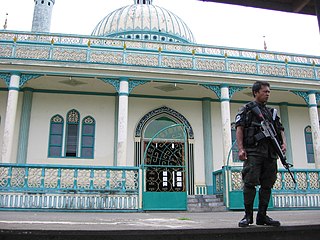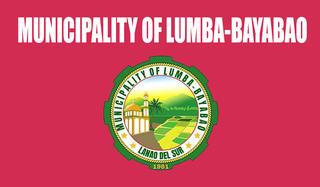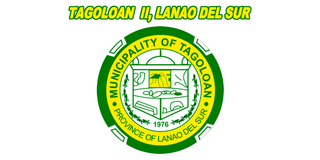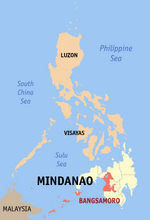
Lanao del Sur, officially the Province of Lanao del Sur, is a province in the Philippines located in the Bangsamoro Autonomous Region in Muslim Mindanao (BARMM). The capital is the city of Marawi, and it borders Lanao del Norte to the north, Bukidnon to the east, and Maguindanao del Norte and Cotabato to the south. To the southwest lies Illana Bay, an arm of the Moro Gulf.

Ganassi, officially the Municipality of Ganassi, is a 4th class municipality in the province of Lanao del Sur, Philippines. According to the 2020 census, it has a population of 30,802 people.

Bacolod-Kalawi, officially the Municipality of Bacolod-Kalawi, is a 3rd class municipality in the province of Lanao del Sur, Philippines. According to the 2020 census, it has a population of 23,129 people.

Balabagan, officially the Municipality of Balabagan, is a 4th class municipality in the province of Lanao del Sur, Philippines. According to the 2020 census, it has a population of 29,863 people.

Bubong, officially the Municipality of Bubong, is a 2nd class municipality in the province of Lanao del Sur, Philippines. According to the 2020 census, it has a population of 26,514 people.

Ditsaan-Ramain, officially the Municipality of Ditsaan-Ramain, is a 3rd class municipality in the province of Lanao del Sur, Philippines. According to the 2020 census, it has a population of 24,406 people.

Kapai, officially the Municipality of Kapai, is a 4th class municipality in the province of Lanao del Sur, Philippines. According to the 2020 census, it has a population of 20,581 people.

Lumba-Bayabao, officially the Municipality of Lumba-Bayabao, is a 2nd class municipality in the province of Lanao del Sur, Philippines. According to the 2020 census, it has a population of 45,909 people.

Lumbayanague, officially the Municipality of Lumbayanague, is a 4th class municipality in the province of Lanao del Sur, Philippines. According to the 2020 census, it has a population of 19,091 people.

Maguing, officially the Municipality of Maguing, is a 2nd class municipality in the province of Lanao del Sur, Philippines. According to the 2020 census, it has a population of 30,436 people.

Malabang, officially the Municipality of Malabang, is a 3rd class municipality in the province of Lanao del Sur, Philippines. According to the 2020 census, it has a population of 49,088 people. The town is one of the two former capitals of the Sultanate of Maguindanao from 1515 until the Spanish conquered the land in 1888.

Marantao, officially the Municipality of Marantao, is a 2nd class municipality in the province of Lanao del Sur, Philippines. According to the 2020 census, it has a population of 37,763 people.

Masiu, officially the Municipality of Masiu, is a 5th class municipality in the province of Lanao del Sur, Philippines. According to the 2020 census, it has a population of 33,580 people.

Mulondo, officially the Municipality of Mulondo, is a 3rd class municipality in the province of Lanao del Sur, Philippines. According to the 2020 census, it has a population of 19,932 people.

Saguiaran, officially the Municipality of Saguiaran, is a 4th class municipality in the province of Lanao del Sur, Philippines. According to the 2020 census, it has a population of 26,712 people.

Picong, officially the Municipality of Picong, is a 4th class municipality in the province of Lanao del Sur, Philippines. According to the 2020 census, it has a population of 18,907 people.

Tagoloan, officially the Municipality of Tagoloan and also known as Tagoloan II, is a 4th class municipality in the province of Lanao del Sur, Philippines. According to the 2020 census, it has a population of 12,602 people.

Tamparan, officially the Municipality of Tamparan, is a 5th class municipality in the province of Lanao del Sur, Philippines. According to the 2020 census, it has a population of 32,074 people.

Taraka, officially the Municipality of Taraka, is a 4th class municipality in the province of Lanao del Sur, Philippines. According to the 2020 census, it has a population of 27,184 people.

Tubaran, officially the Municipality of Tubaran, is a 4th class municipality in the province of Lanao del Sur, Philippines. According to the 2020 census, it has a population of 16,896 people.
























